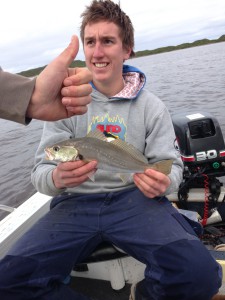Help us learn more about the elusive Mulloway…
Over the past 10 years of holidaying at Nelson, I’ve taken great interest in the different yarns told by the locals about the all mighty Mulloway in the Glenelg River. There are even some ‘old salts’ that fish the beaches along South Australia, who claim to be able to ‘smell’ schools of mulloway from the shore. In a quest to unlock some of the mysteries surrounding this species, Nature Glenelg Trust has recently received funding from Department of Environment and Primary Industries to undertake research on Mulloway in western Victoria.
For those of you that fish the Glenelg and Hopkins rivers regularly, you will know that this year has seen a significant number of undersize Mulloway being caught, typically measuring between 40-60 mm total length. It is believed that these juveniles may be the result of bumper spawning and recruitment events, thought to have occurred near the mouth of the Murray River in response to high freshwater flows in 2010. One of the aims of the project is to therefore learn more about the connectivity between these two seemingly distinct geographic populations.

Keen angler Luke Veale, snapping a quick photo of an undersized Mulloway caught in the Glenelg River before returning it to the water.
Research on the age structures, growth rates and reproductive characteristics of Mulloway is currently underway. A full run down on the project is available in this recent media release: 23rd Oct 2014 Media Release – NGT Mulloway Research
Determining the age structures of a population is an important factor when assessing the biology and status of a fishery. Some people may be aware that fish are accurately aged by counting annually formed growth bands in their otoliths, otherwise known as “jewels” or “fish ear bones”. Fish in fact have three pairs of otoliths, the largest of which are the sagittae. These are found just behind the brain (and eyes) and help fish maintain their position in the water column.

Three sets of otolith pairs, extracted from Mulloway that were 88 (left), 110 (middle) and 87 mm (right) in total length.
A vital part of this project is the collection of biological information from recreational fishers. If you catch Mulloway in the Glenelg River, Hopkins River or marine waters along the south-west coastline you can be an active participant in this research by donating your filleted fish frames.
Please refer to this flyer for more information on how to get involved: Mulloway research- flyer for recreational fishers, or contact Lauren Veale on 0439 034 390 / .


